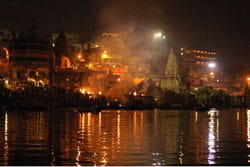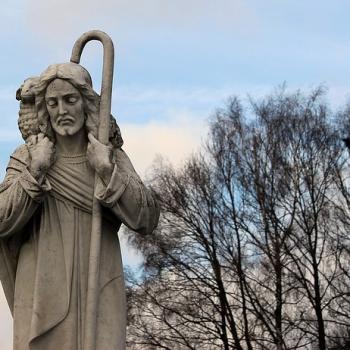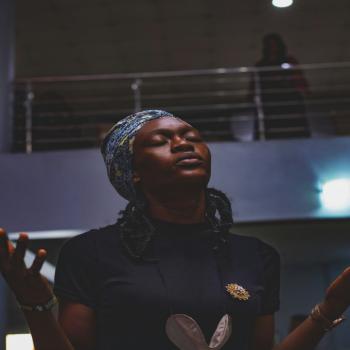By Ananya Vajpeyi
 Varanasi, on the banks of the river Ganga, is one of the holiest cities for Hindus in India. It is more popularly known as Benares or Kashi, both old names that can be found in colonial as well as medieval accounts. For pious Hindus, Kashi is where one goes to die. Death in Kashi is supposed to release a soul from the cycle of rebirth, into a final and limitless liberation. Some Hindus seek to live out their last days in Kashi; others specifically ask that their bodies be cremated on Manikarnika Ghat, a stepped embankment that is considered to be the city's most hallowed cremation site.
Varanasi, on the banks of the river Ganga, is one of the holiest cities for Hindus in India. It is more popularly known as Benares or Kashi, both old names that can be found in colonial as well as medieval accounts. For pious Hindus, Kashi is where one goes to die. Death in Kashi is supposed to release a soul from the cycle of rebirth, into a final and limitless liberation. Some Hindus seek to live out their last days in Kashi; others specifically ask that their bodies be cremated on Manikarnika Ghat, a stepped embankment that is considered to be the city's most hallowed cremation site.
In early January I was in Benares -- an auspicious start to the year. One evening my two companions and I engaged a boat to another famous ghat, Dasasvamedh, so that we could watch evening prayers offered to the Ganga. After we had finished admiring the spectacular hour-long prayers from the water, the boatman asked me whether I wanted him to take us further, to Manikarnika. "Most visitors to this city go there," he said, pulling out of a small traffic jam of boats, all of which carried spectators like us. "After dusk you can see the flames more clearly than in the daytime." I pictured the sight in my mind, and then declined his offer. "Take us back to Assi Ghat," I said, referring to the place where we had boarded the boat.
The boatman, a funny and talkative fellow, wanted to know why I did not wish to see Manikarnika with its burning pyres spectacular in the early evening darkness, and its promise of eternal liberation for those being cremated. I reminded him that among most Hindu communities, women are not encouraged to look at a dead body or attend a funeral, even within the immediate family. "Ah yes," he assented, turning the boat around to take us back. "A woman has to be a mother. If she sees death, she will not be able to give birth." I nodded in agreement, and we proceeded into the damp misty air over the water that was strangely warm on a cold January night.
It is indeed an old Hindu belief that those who are responsible for the birth and care of new life ought to be shielded from the realization of our ineluctable mortality. Piety wasn't my real reason for avoiding Manikarnika, though. I am scarcely religious at all in my personal life. The truth is I felt a visceral distaste for the idea of watching bodies burn, relatives mourn the dead, and bones and ashes be carried away by the waters of the holy river. I could not bring myself to crash a stranger's cremation as though it were some kind of sound-and-light show for the entertainment of tourists like me.
There wasn't a dearth of death in Benares; as one walked or drove on its streets, small groups of men bearing the dead on biers kept passing by with little fanfare about the nature of their procession. I saw many more dead bodies in three days in Benares than I had seen in the preceding thirty years. Unlike other Indian cities, this one does not go out of its way to separate and shield the living and the dead from one another. The two categories of bodies form a continuum; life and death remain in conversation with one another.
At the Kashi Vishwanath Mandir, a gold-spired temple to Shiva in the heart of Benares, and the very seat and nerve center of the city's spiritual power, one experiences the body not only as utterly vital, but also as inseparable from other bodies. The temple as it stands today was built in the last quarter of the 18th century under the patronage of a queen, Maharani Ahalya Bai Holkar, of Indore. A few decades later, around 1840, two of its domes were covered with gold, thanks to the king of Punjab, Maharaja Ranjit Singh. But it is said that the site itself has been holy for thousands of years.
A mass of devotees and visitors enters the sanctum sanctorum in a single unbroken surge, pushed through a tiny door in and a tiny door out. Shiva, signified through his mark or sign ("linga") in the form of an erect phallus, is the regnant deity of Kashi. The city is balanced, it is said in ancient Hindu mythology, on the trident of Shiva, his characteristic weapon. To see the Shiva-linga inside the Vishwanath Temple, which is known as a Sign of Light ("jyotirlinga"), one has to become completely oblivious of the limits of one's corporeal self. The crowd pushes one forward to the god; after a brief glimpse, the crowd pulls one away from him.
As I join the line of waiting devotees, I too carry the usual offerings: a pot of milk, a bag of rose petals, and my faith ("shraddha" in Sanskrit) that allows me to regard this place as holy. How these offerings leave my hands and pour onto the god, I do not know. How I am propelled toward Shiva and then back out into the temple's tranquil courtyard, I cannot say. Somewhere in the midst of a hundred keening bodies is the body I call my own, but I have no sense of where it might begin or end, or how I might gather myself to myself so as to leave out those who surround and engulf me. In the precincts of the temple, bodies are water, they ebb and flow as one river. After spending an hour or two in this way, I am rendered so forgetful of my own physical boundaries and needs, that I leave the temple, its street, and its labyrinthine neighborhood of narrow winding alleys without retrieving the shoes I had removed before entering the temple. Only when I reach the main road do I realize that I had walked away barefoot.




